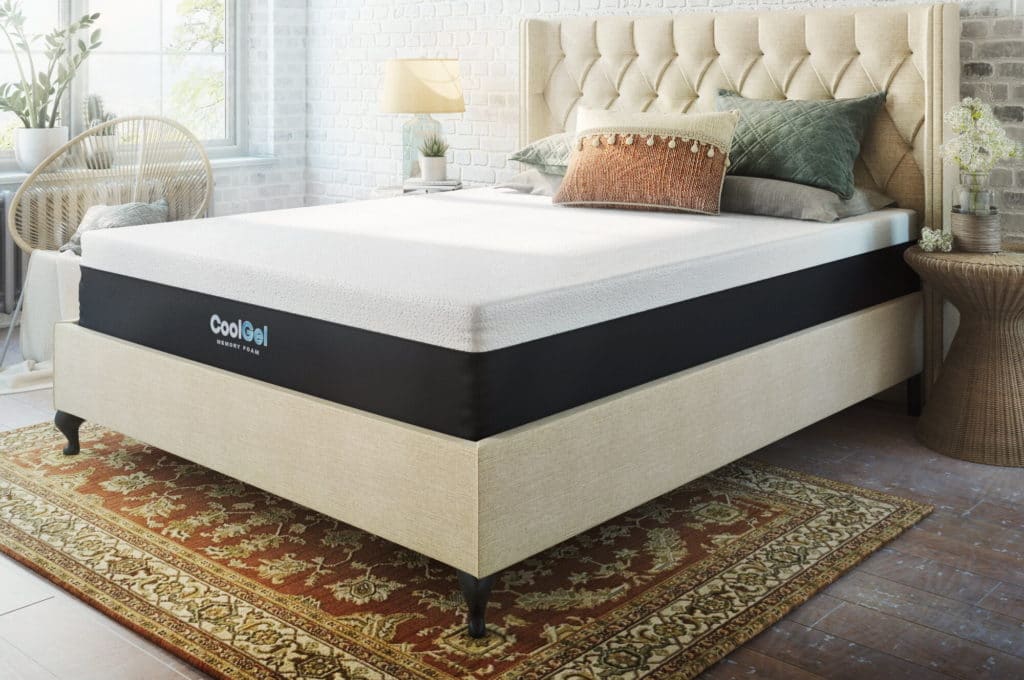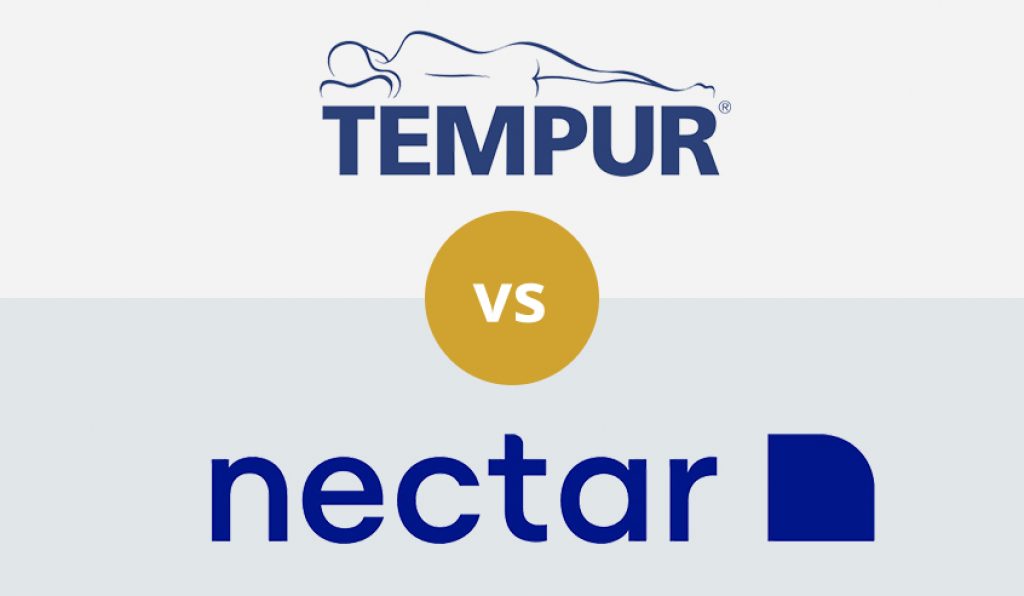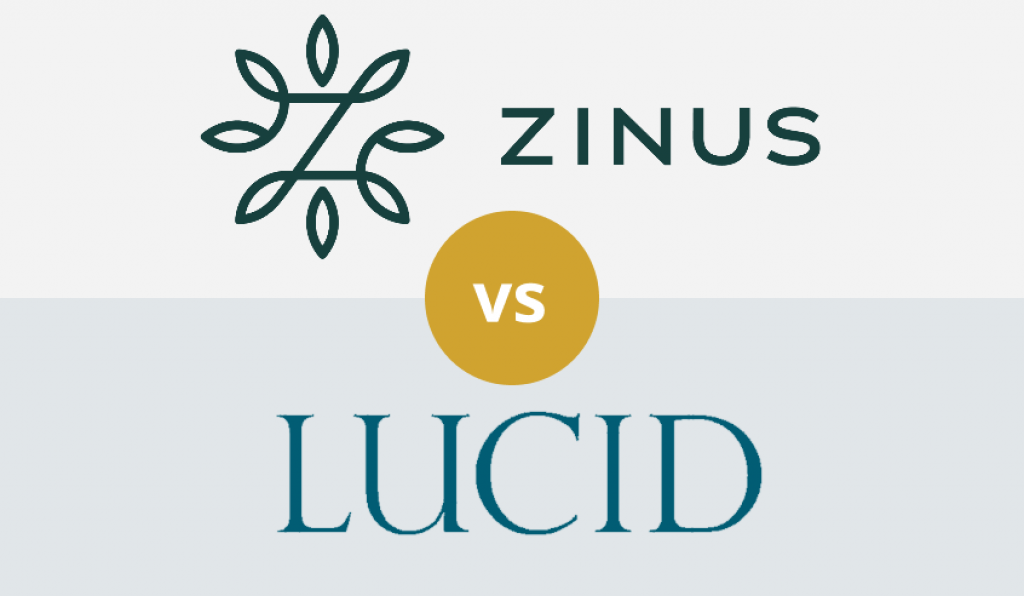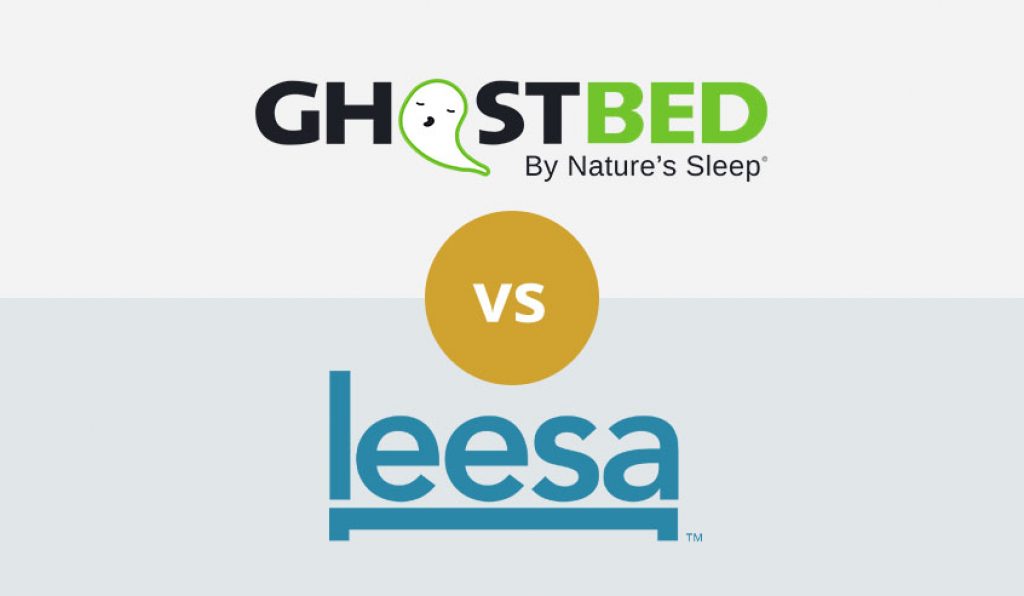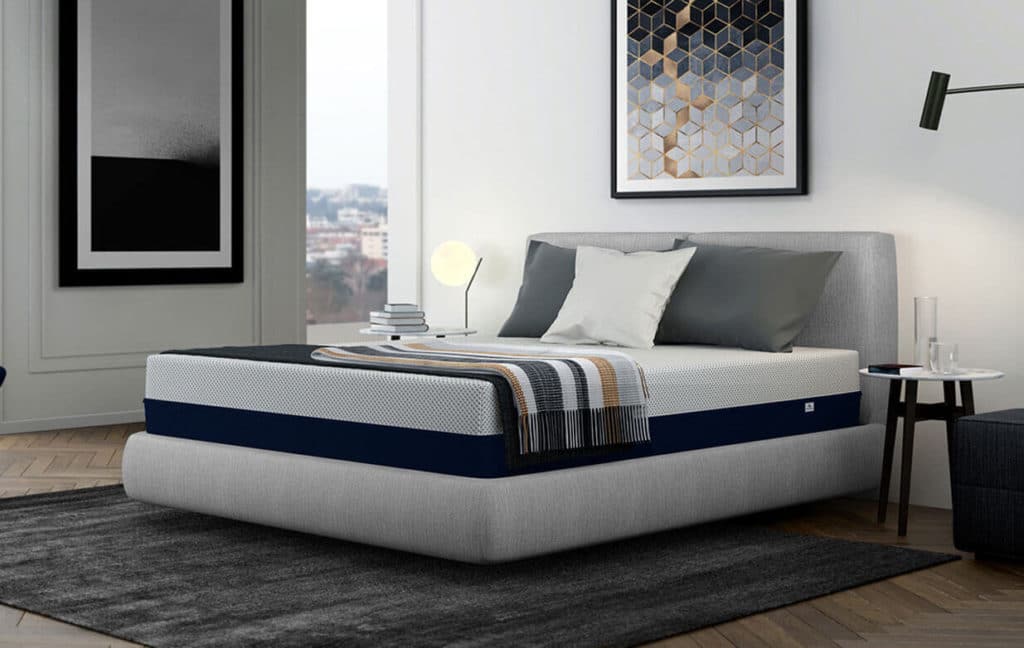

In recent years, there have been many mattress companies that have launched new and exciting designs, as we have started to understand more about what makes a mattress suitable for you and your sleeping position as well as any other ailments. Does mattress thickness matter?
The answer is “yes”. Mattress thickness is a hugely important factor that you should consider before you make any purchase. A thicker mattress will usually offer more support and comfort, but there are a number of different factors that play a part in the design of a mattress. For instance, is it a hybrid design?
In this guide, we’re looking at the ideal thickness for mattresses and whether or not a certain size is for you. We also look at the dimensions of popular bed sizes, what thickness they are likely to offer, and how to measure mattress thickness to know what you are dealing with.
When you’re trying to work out what thickness memory foam mattress is best for you, you should consider the different layers within. The thickness is created by the layering that goes on inside mattresses. The different layers have their own functions, whether it be for your comfort or to take more of your weight. Some layers may be purely to keep you cool on hot days.
Before we look into a mattress thickness guide, it is worth fully understanding what makes up this size. What is within that 10 or 12 inches of mattress? Is a pillow top mattress thickness higher because of what is on the top? We discuss the layers and the average mattress thickness below.
As you probably know, most mattresses have springs. The support layer is where these springs will be located. They help to give support and spread the weight of a person laying on the bed. Obviously, springs aren’t comfortable to lay on, so the other layers make the bed far comfier.
The support layer often also has high-density foam which can be called reflex foam. In extreme examples this is used instead of springs and gives all of the support properties.
The comfort layer is the closest to the surface. Different brands use different materials to create a comfy surface for people to lay on. There are lots of different options. Often, natural fillings are popular. Things like wool or cotton, or even horsehair can be an ideal way to stay comfort, especially for people who stay in the same position while they sleep. Latex, which is durable while also comfy, is another popular material.
Foam layers may be used to give extra durability and a really soft finish, but it does mean that the mattress tends to be more expensive. The same applies for memory foam. These comfort layers are great for handling pressure points and giving a finish that keeps you comfortable all through the night. Some comfort layers also include things like gels to keep you cool if you live in a warm environment.
Mattresses have a number of covers. Some manufacturers even let you choose what cover you would like.
Knitted covers offer a fabric with elastic properties, they’re popular on memory foam models and they are breathable so even in hot environments they are suitable.
Damask covers have a hard-wearing design that is woven. They can last a long time.
Tufted and quilted covers also provide you with an extra level of warmth. This is ideal if you need to snuggle up to get warm on a cold winter’s night. Covers are often washable and replaceable so if you experience any issues with your cover, you can buy another. You might even have warmer covers for different times of the year.
Mattress depth has a big impact on your comfort and the beneficial properties that a mattress can have. If you’re wondering what thickness memory foam mattress is best or whether you need all 14 inches of a mattress depth, the guide below will help you to make your decision on mattress depth. Remember that depth is just one part of the equation. If you have 14 inches of depth but what is inside doesn’t give you any level of support then you might as well be using a much thinner mattress.
These are known as low profile mattresses. For a fully-grown adult, they’re not suitable for long-term use. You might find these in cribs, but also for foldaway or travel beds. Such thin mattresses are only suitable for short-term use as they don’t offer the right level of support, but for children and smaller frames they may be suitable.
These are known as slim mattresses. They’re accessible as they make it easy to get in and out of bed, so for people with mobility problems this might be an ideal choice. They often have condensed foam to offer enough support in spite of the smaller size. Some of the tighter-wound foams can be a good option for smaller 6-8 inch mattresses.
This is a standard mattress size that you will often find on standard bed sizes including king and queen. Around 10 inches is the average mattress size and a typical mattress thickness on an adult bed, but you can get bigger mattresses. Most of the big mattress brands make something in this range. If you are looking for a hybrid mattress, a 10- or 11-inch thickness is pretty standard, but some are a little higher than this, too.
These are quite large, but a lot of new hybrid mattresses featuring new and exciting support layers and comfort functionality are in this size, like the Layla Hybrid Mattress. Medium to thick mattresses are becoming the norm. Hybrid models include extra layers, that might add 2-4 inches of height. Some have cooling gel layers, for example. This extra size means extra cost, too.
These very thick mattresses can be harder to transport, and this means they tend to be more expensive. On top of that, you should consider the fact that these mattresses often require specific frames. They’re luxurious and can be very comfortable, but this is not a standard thickness of mattress you’ll find in most homes. It’s a specialist product, so you won’t see a lot of mattresses on the market in this size.
There are a number of different options for mattress sizes and the thicknesses that usually go with them. A pillow top mattress thickness will add 2-4 inches to the thickness of a mattress. Consider this before you make a purchase.
Futons are great for sleep or for sitting and relaxing. The average futon mattress thickness is between 3 and 9 inches. Thicker models tend to have a little more comfort and padding for sleep.
A standard twin mattress thickness is normally between 8 inches and 13 inches. The XL variety is likely to be at the higher and of this normal mattress thickness.
Most full-size mattresses are somewhere between 8 to 14 inches in size. This standard mattress thickness may well be what you have on your current bed. An average size is 10 or 11 inches.
Similarly, a standard queen mattress thickness will have an 8–14-inch size though they might be on the lower end of this average mattress thickness.
King size mattress thickness still sits in this range but you are likely to see them between 10 and 14 inches in thickness. The Brooklyn Sedona Hybrid is an example of a 14 inch model of King size mattress.
A luxury California king mattress thickness could be 14-16 inches or even higher if you are looking for the ultimate in luxury. Some people have 20-inch mattresses, which you truly can sink into for comfort. As you might expect, though, they’re usually far more expensive.
A lot of people have to choose their mattress based on medical conditions. How thick should a mattress be for your own needs? If you have a chronic or serious medical condition, you should consult a physician about your sleeping position, especially if you feel that it could be contributing. We’ve covered some common ailments and why the thickness plays such a big part in the decision you will make.
Mattress thickness for back pain could be anywhere from 9 inches upwards. The main thing is to get a firm or medium firm mattress so that you get enough support. There are many great back pain mattresses on the market to tackle this common issue. Rest in bed is one of the most effective ways Trusted Source Bed rest for back pain? A little bit will do you. - Harvard Health Bed rest can give you a break when standing or sitting causes severe pain. Too much may make back pain worse. Here is how to do bed rest “right.” www.health.harvard.edu to treat this kind of pain, but not if you have a bed that is not suitable and doesn’t give you the level of support you need.
Thicker models from 10 inches upwards might well be good for your hip pain. Again, you need some level of firmness as well as getting the right mattress thickness for hip pain. Don’t delve below 8 inches of thickness if you suffer regularly from hip pain.
A medium-firm mattress with an 8-inch depth or above is the ideal mattress thickness for shoulder and arm pain. You may also need to consider your sleeping position as certain positions that put weight on one side could cause you more issues when it comes to shoulder or arm pain.
A lot of pregnant women prefer thicker profiles and any mattress that enables them to get in and out of bed easily. The main thing is to remain comfortable, and climbing on top of a 20-inch mattress might not be an ideal solution for this.
10–12-inch mattress heights are fine for most stomach sleepers, but firmer support is needed if you are heavier, otherwise, you will sink in and not get the firmness you require.
If you are a back sleeper and you need a lot of support when you are sleeping then you might find a thicker mattress is more suitable for your needs. 12 inches or above, especially for heavier individuals.
Lighter side sleepers can get away with slightly lower firmness but any thickness is usually fine for a side sleeper. Once again, a medium thickness is wise if you are looking for this type of mattress. Heavy side sleepers need plenty of support, so don’t dip below 8 inches of thickness.
If you sleep in a combination of positions through the night then your mattress height can be whatever shape and size you feel most comfortable, we recommend over 10 inches if you are a heavier individual.
Different brands have different mattress properties. As well as offering differences in height, many mattresses also have different materials inside. This can impact the support level more than the thickness itself.
The Purple mattress thickness varies between 9.25 and 13 inches depending on the model. These mattresses contain two base layers of foam and an additional layer of Purple’s Hyper-Elastic Polymer.
Casper mattresses include recycled polyester, upcycled cotton, rayon, and lycra, and the Casper mattress thickness is 11 inches by default. There are other models in the range with slightly different designs.
The Nectar mattress thickness is 11 inches, which is close to the average mattress thickness. This mattress includes materials like high-density memory foam as well as a core made of high-density polyfoam.
The Tempurpedic mattress thickness is 12 inches by default. It’s a very supportive model of mattress, great for people who have existing health issues. The base is made out of non-visco-elastic, high-density polyurethane foam.
The Leesa mattress thickness is 10 inches, but they do also offer a hybrid bed that is 11 inches thick. There is a high-density foam layer for support as well as a comfortable Avena foam. The mattress comes encased in fire retardant materials using a blend of fibers to give comfort but also stop the mattress from being flammable.
The original Tuft and Needle mattress thickness is 10 inches, but they offer other models, one of which has a larger 11-inch design. The materials of the standard Tuft and Needle model include polyfoam, micro-polyamide and a polyester cover on the mattress.
Because bunk beds are space-saving options it is common to find that bunk bed mattress thickness is actually much thinner than some of the other types on the market. 6-8 inches is fairly common for this type of bed. For heavier bunk bed users this might be uncomfortable, so it could be worth investing in a mattress with more support. However, you need to be careful as you do not want to add a bunk bed mattress that is too big for the support rails or platform.
Each bed frame is different and you need to make your choice of mattress thickness for platform bed based on the specific model you purchase. However, it is usually an option to get a bigger mattress depth as the platform bed will sit lower towards the ground. 12 inches or above is normally a good idea, and you may be able to buy both the mattress and the platform together. If you are one of the people who wants to go for a thick mattress like a 20-inch model then a platform bed might be a good option, and can also make it easier for you to get in and out. We’ve created a full guide to platform bed mattresses, that can help you to choose between 10 of the very best options.
There are so many different factors to consider when you are choosing your mattress, and luckily, there is more choice than ever before on the market. Whether you are a lighter individual or you need a heavier mattress to support your frame, you can choose your design based on your size and your needs. For example, if you have any specific ailments or illnesses, or you experience chronic pain.
One of the most important things to understand is mattress thickness. Though it is not the only thing to think about, you need to work out what thickness will be a good fit for your bed, and for your body. Thicker mattresses may give more of a luxurious feel, but they are expensive. Go for something too thick, and you might be susceptible to more aches and pains.
